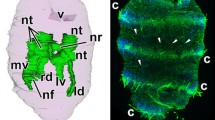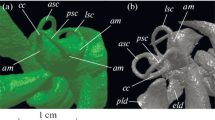Abstract
The process of labyrinth determination has been studied in three urodelean and seven anuran species by means of homoplastic transplantation of ear region epidermis, defined as the piece of epidermal layer containing the material of the prospective ear vesicle (labyrinth rudiment). The ear region epidermis was grafted onto the abdominal wall of embryos of the same developmental stage. The earliest stage of operation resulting in ectopic ear vesicle formation was determined, suggesting the appearance of organ-specific properties in the ear ectoderm. These properties were enhanced in the further course of development, as indicated by the frequency of ear vesicle formation and by the volume and degree of complexity that the vesicles reached. The data obtained allowed us to arrange the species studied in a sequence, ranging from most Ranidae and Bufo viridis, in which organ-specific properties appear earlier and are most strongly expressed, to Triturus vulgaris in which their expression is least pronounced. Comparison of properties of the material giving rise to the ear vesicle or to several other ectodermal derivatives led to the conclusion that species-specific differences in determination of different ectodermal rudiments are due to species specific properties of the whole ectoderm. These differences appear to be determined by an evolutionary shift of the beginning of gastrulation towards later cleavage cycles.
Article PDF
Similar content being viewed by others
Avoid common mistakes on your manuscript.
References
Dettlaff TA (1956) Species-specific differences in the morphogenetic properties of the embryonic material and the shift of gastrulation with reference to the cleavage stages (in Russian). Dokl Akad Nauk SSSR 111: 1149–1152
Dettlaff TA (1964) Cell divisions, duration of interkinetic states and differentiation in early stages of embryonic development. Adv Morphogenet 3: 323–362
Dettlaff TA, Dettlaff AA (1961) On relative dimensionless characteristics of the development duration in embryology. Arch Biol 72: 1–16
Dettlaff TA, Ignatieva GM, Vassetzky SG (1987) The problem of time in developmental biology: its study by use of relative characteristics of developmental duration. Soc Sci Rev Fr Physiol Gen Biol 1: 1–88
Filatov DP (1925) Ersatz des linsenbildenden Epithels von Rana esculenta durch Bauchepithel von Bufo vulgaris. Roux's Arch Dev Biol 105: 474–482
Ginsburg AS (1950) Species-specific features of the initial stages of labyrinth development in amphibians (in Russian). Dokl Akad Nauk SSSR 73: 229–323
Jacobson AG (1966) Inductive processes in embryonic development. Science 152: 25–34
Liedke KB (1942) Lens competence in Rana pipiens. J Exp Zool 90: 331–351
Pasteels JJ (1953) Les effets de la centrifugation sur la blastula et la jeune gastrula des Amphibiens. I, II. J Embryol Exp Morphol l: 5–24; 125–145
Pasteels JJ (1954) Les effets de la centrifugation sur la blastula et la jeune gastrula des Amphibiens. III, IV. J Embryol Exp Morphol 2:122–148
Popov V, Kislov M, Nikitenki M, Chanturishvili P (1938) About the lens-forming ability of the head and trunk epithelium in Pelobates fuscus, Bufo viridis, Bombina bombina and Triton cristatus (in Russian). Proc Inst Exp Morphogenesis, Moscow State University 6: 149–173
Spemann H (1912) Zur Entwicklung des Wirbeltierauges. Zool Jahrb [Allgem Zool Physiol] 32: 1–98
Ten Cate G (1956) The intristic embryonic development. North-Holland, Amsterdam
Ubisch L von (1924) Über den Einfluss verschieden hoher Temperatur auf die Bildung der Linse von Rana fusca, Rana esculenta und Bominator pachypus. Z Wiss Zool 23: 37–102
Yntema CL (1950) An analysis of induction of the ear from foreign ectoderm in the salamander embryo. J Exp Zool 113: 211–244
Yntema CL (1955) Ear and nose. In: Willier BH, Weiss PA, Hamburger V (eds) Analysis of development.Saunders, Philadelphia, pp 415–428
Author information
Authors and Affiliations
Additional information
Deceased in November 1993
Rights and permissions
About this article
Cite this article
Ginsburgt, A.S. Determination of the labyrinth in different amphibian species and its correlation with determination of the other ectoderm derivatives. Roux's Arch Dev Biol 204, 351–358 (1995). https://doi.org/10.1007/BF00360480
Received:
Accepted:
Issue Date:
DOI: https://doi.org/10.1007/BF00360480




